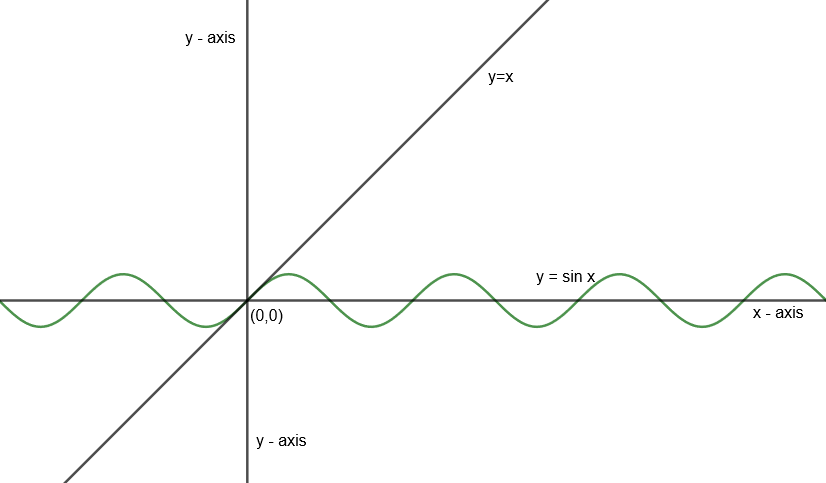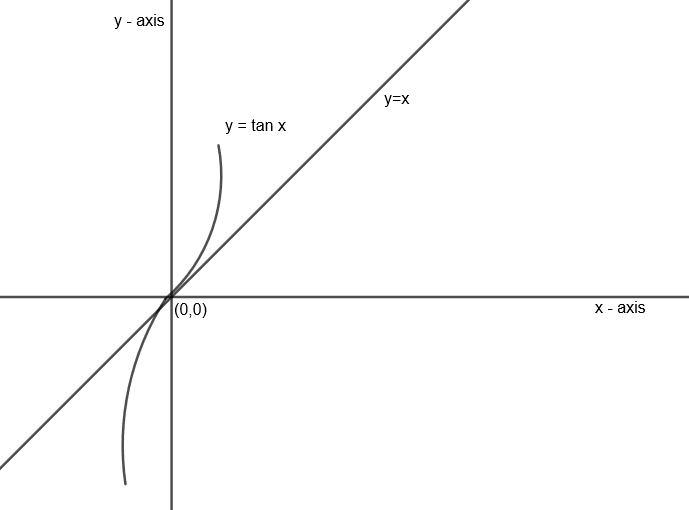Question
Question: Let \(\underset{x\to 0}{\mathop{\lim }}\,{{\sec }^{-1}}\left( \dfrac{x}{\sin x} \right)=l\) and \[\u...
Let x→0limsec−1(sinxx)=l and x→0limsec−1(tanxx)=m, then
(a) l exists but m does not
(b) m exists but l does not
(c) l and m both exist
(d) neither l nor m exists
Solution
Hint: Relate the relation between x, sin x and tan x when x is limiting to zero. Relate it with the domain of sec−1x for existing limits.
Here, we have given the limits as
x→0limsec−1(sinxx)=l....(i)
And, x→0limsec−1(tanxx)=m.....(ii)
First, we need to know about the domain of sec−1x i.e. (−∞,−1]∪[1,∞).
Now, try to relate values of sinxx and tanxx for limit x→0, if value inside of sec−1() will lie in (−1,1) then limit will not exist and if value inside the bracket lies in (−∞,−1]∪[1,∞). Hence limit will exist.
Let us first relate sinxx.
One can relate x with sin x and tan x by calculating tangent equations of tan x and sin x at (0, 0) and relate it with y = x.
We know that one can find tangent at any point lying on the curve by calculating slope at that point. Let the point be (x1,y1) and curve is y = f (x) then tangent at (x1,y1) can be given by y−y1=dxdy(x1,y1)(x−x1)
Tangent equation for sin x at (0, 0) is
y−0=dxd(sinx)(0,0)(x−0)
y=cosx∣(0,0)(x) [∵dxdsinx=cosx]
y=x
Hence, y=x is tangent for y=sinx.
Draw graph of x and sin x in one coordinate plane as follows:

Now for the second case i.e. tanxx, we get the tangent equation of tan x at (0, 0) is
y−0=dxdy(0,0)(x−0)
y=sec2x(0,0)(x) [dxdtanx=sec2x]
y=x
Hence, y = x is tangent for y=tanx as well.
Let us draw the graph of x and tan x as follows:
 Now from the graphs, we can relate for sinxx that is:
Now from the graphs, we can relate for sinxx that is:
Case 1: x→0+
We observe x > sin x
Hence, sinxx>1
Case 2: x→0−
Here, sin x has a higher positive magnitude than x. Hence, if we put a negative sign to both x and sin x, then
x>sinx
sinxx>1
Hence, from case 1 and case 2, we get
If limx→0, then sinxx>1....(iii)
Similarly, let us relate x and tan x for x→0
Case 1: x→0+
x < tan x
tanxx<1
Case 2: x→0−
x < tan x
tanxx<1
Hence, for x→0, we have tanxx<1....(iv)
Now, for limit ‘l’ from equation (i), we get
l=x→0limsec−1(sinxx)
As we have sinxx>1 from equation (iii) and domain of sec−1x is (−∞,−1]∪[1,∞) as explained in the starting. Hence, we can put limx→0 to the given relation.
So, l=x→0limsec−1(sinxx) will exist.
For limit ‘m’ from equation (ii), we get
m=x→0limsec−1(tanxx)
We have already calculated that tanxx<1 from equation (iv) and domain of sec−1x is (−∞,−1]∪[1,∞). Hence the given limit will not exist.
Hence, option (a) is the correct answer to the given problem.
Note: One can directly put x→0limsinxx=1 and x→0limtanxx=1 as we generally use but that will be wrong for the given expression. As the exact value of x→0limsinxx and x→0limtanxx is not exactly 1, it’s the limiting value of the given expressions. Hence, be careful with these kinds of problems. Relating x with tan x and sin x by calculating tangent at (0, 0) for sin x and tan x is the key point of the question.
